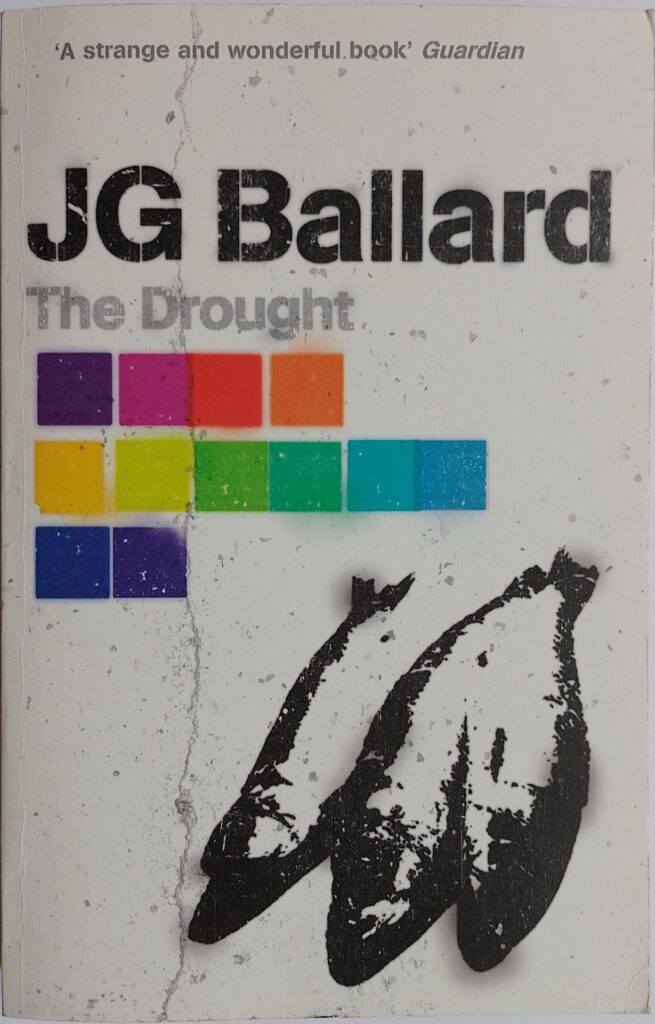First published 1965. Fourth Estate, paperback, 2011, pp 233 (+7 pages of commentary), c. 72,000 words (main text).
The opening page develops a surreal, trippy atmosphere by the use of unusual adjectives, adverbs, similes and metaphors, piling one on top of another. I feared that this would make the book hard reading, but in Ballard’s skilful writing, it creates a coherent if unsettling atmosphere that soon becomes readily and enjoyably digestible.
The story opens with Charles Ransom surveying the dropping water level in the river where he lives on a houseboat. A drought has taken hold and shows no sign of ending. Some of the other folk living on or near the river bring to mind The Tempest: Philip Jordan, an Aeriel-like youth and Quilter, a physically and mentally deformed young man akin to Caliban. Ballard later makes the connection explicit and also lists The Tempest amongst his ten favourite reads in the afterword. Ransom, a doctor, seems to have no strong relationships: his wife left him some time ago, he is vaguely attracted to Catherine, a zoo keeper, and encounters neighbours such as Lomax and The Reverend Johnson, whom he knows but doesn’t seem close to.
As the drought worsens, people start leaving for the south coast. The town becomes depopulated and anarchy starts to take hold. Ransom is undecided, but eventually is pushed into leaving when the nearby town starts being destroyed and violence seems to be getting the upper hand. He has left it too late to use his barge to sail out to sea: it has become stranded; leaving it too late is a familiar Ballard theme, see for example High Rise. By accident rather than design, he journeys to the coast in the company of some of his acquaintances: Philip, Catherine, Quilter’s mother, and Philip’s foster father.
The coast is hugely crowded and it is impossible to get to the sea itself. The military have erected a fence to control access and have built distillation plants but the pressure of desperate people soon means that anarchy takes hold here too. In this second section, Lear has replaced The Tempest. The Revered Johnson is Lear, ruling a small community of survivors, but he has become senile and it is his daughters who control things. Ransom is an outsider, rejoined by his wife, not because of any return of love but as a matter of survival. In the third section, The Tempest once again becomes dominant.
Ballard is a master of the dystopian, not only describing a society fragmenting under pressure but also a personal dystopia. Ransom never engages with anyone to any depth. While he struggles hard, somehow all his efforts are in vain, and he fails to connect. It is a dream state and one of the human conditions that we all must feel at times, and here it is greatly magnified, just as the drought itself is taken to the extreme, resulting in the desertification of the landscape, pollution and destruction everywhere and the collapse of civilisation.
This is an outstanding piece of atmospheric writing. The use of language builds the picture of disconnectedness, the lack of any engagement in relationships. Just occasionally it becomes overwrought, but frequently he casts a gem: ‘…but now he felt the white deck of the river was carrying them all in the opposite direction, forward into zones of time future where the unresolved issues of the past would appear smoothed and rounded, muffled by the detritus of time, like images in a clouded mirror.’ [ p186]
Ballard draws a nightmare dreamscape. While it is far from realism, it explores deep feelings and the fundamental human struggle in relating to our fellows to derive meaning in our lives. It is a powerfully drawn but bleak vision.
© William John Graham, December 2022

